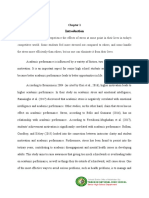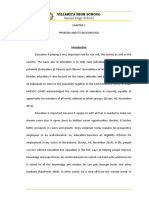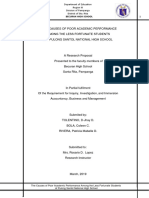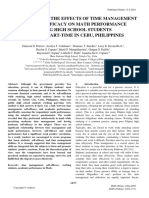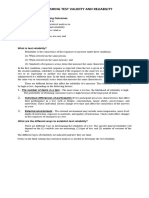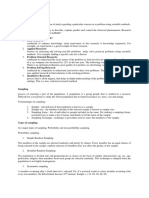Overcrowded Classroom
Overcrowded Classroom
Uploaded by
JOSEPH C. INGGANCopyright:
Available Formats
Overcrowded Classroom
Overcrowded Classroom
Uploaded by
JOSEPH C. INGGANOriginal Description:
Original Title
Copyright
Available Formats
Share this document
Did you find this document useful?
Is this content inappropriate?
Copyright:
Available Formats
Overcrowded Classroom
Overcrowded Classroom
Uploaded by
JOSEPH C. INGGANCopyright:
Available Formats
Chapter 2
RESEARCH METHODOLOGY
Research Design
The researcher will use the descriptive correlational design to gather and assess data.
Descriptive research is defined as a research method that involves observing behavior to describe
attributes, objectively and systematically. According to John Best, 1998, descriptive research
describes and interprets what is. It is concerned with conditions of relationship that exists; practices
that prevail; beliefs, processes that are being felt, or trends that are developing.
Correlational research, on the other hand, is a method that describes and predicts how
variables are naturally related in the real world, without any attempt by the researcher to alter them
or assign causation between them.
The main objective of descriptive research is to create a snapshot of the current state of
affairs whereas correlational research helps in comparing two or more entities or variables.
This design will be used to describe the independent variables of this study that include the
demographic profile of the respondents; age, sex, grade level, highest educational attainment of
parents, parents’ monthly income, occupation of parents, number of siblings, and birth order.
These variables are being correlated to the academic performance of the learners.
Respondents of the Study
The respondents of this study will be the 125 students of junior high schools of Lasam, for
the school year 2019-2020. Random sampling will be used in identifying 21 junior high school
students in 5 secondary schools of Lasam to serve as respondents.
Junior High Schools of Lasam (both public and private) Number of
respondents
Cabatacan National High School 25
Callao National High School 25
Nabannagan National High School 25
Sicalao Integrated School 25
Western Cagayan School of Arts and Trades 25
Total 125
Research Instrument
In this study, this researcher will use the questionnaire to gather data from the students and
teachers. To supplement the questionnaire, informal interview will be conducted.
Questionnaire. According to Aquino, 1999, it is a list of planned, written questions related
to a particular topic, with space provided for indicating the response to each question, intended for
submission to a number of persons for reply.
The questionnaire may be self-administered, posted or presented in an interview format. A
questionnaire may include check lists, attitude scales, projective techniques, rating scales and a
variety of other research methods. As an important research instrument and a tool for data
collection, a questionnaire has its main function as measurement (Oppenheim 100). It is the main
data collection method in surveys and yield to quantitative data. Also, due to provision for open
endedness, the instrument may be used to generate qualitative and exploratory data (Dornyei 101)
Data Gathering Procedure
This researcher will ask permission to conduct the study from the Schools Division
Superintendent of Cagayan through the School Head of this researcher.
After the approval, this researcher will request the school heads of each school to
personally float the questionnaire to ensure a 100% retrieval.
Statistical Treatment of Data
The statistical tools be used in this study are the descriptive tools only. The data gathered
will be interpreted using the simple frequency count, weighted mean and simple percentage.
The weighted was developed using the Five-Point Likert Scale as follows:
Scale Range Verbal Description
5 4.20 – 5.00 Strongly Agree
4 3.40 – 4.19 Agree
3 2.60 – 3.39 Undecided
2 1.80 – 2.59 Disagree
1 1.00 – 1.79 Strongly Disagree
You might also like
- Practical Research 1Document83 pagesPractical Research 1Lei ClimacosaNo ratings yet
- Critical Appraisal of A JournalDocument29 pagesCritical Appraisal of A Journalmonique marwick100% (2)
- Statistics and Probability STAT 112 Grade11 Week 11 20lebDocument71 pagesStatistics and Probability STAT 112 Grade11 Week 11 20lebRenan Miranda90% (21)
- Chapter 3 FACTORS AFFECTING THE ACADEMIC PERFORMANCE OF SENIDocument7 pagesChapter 3 FACTORS AFFECTING THE ACADEMIC PERFORMANCE OF SENIMillet CastilloNo ratings yet
- 22 ImpactofOvercrowdedDocument24 pages22 ImpactofOvercrowdedMichael Quezon100% (1)
- Overcrowded Classes in Students' EyesDocument10 pagesOvercrowded Classes in Students' EyesDavidNo ratings yet
- The Effect of Parental Involvement On The Academic Performance of Grade 11 TVL Students During Covid 19 PandemicDocument12 pagesThe Effect of Parental Involvement On The Academic Performance of Grade 11 TVL Students During Covid 19 PandemicJason BanayNo ratings yet
- Review of Literature On HomeworkDocument10 pagesReview of Literature On HomeworkJanen Vea Padua DavidNo ratings yet
- The Problem and Its BackgroundDocument49 pagesThe Problem and Its Backgroundkimberly merleNo ratings yet
- The Impact of Overcrowding On Academic Performanc of Senior HighDocument6 pagesThe Impact of Overcrowding On Academic Performanc of Senior Highellajvrrr29No ratings yet
- Research Final The Impact of Homework Activities To StudentsDocument17 pagesResearch Final The Impact of Homework Activities To StudentsJemson FerrarenNo ratings yet
- The Relationship Between Perceived Parental Involvement Among SHS Students Academic Motivation v.70Document62 pagesThe Relationship Between Perceived Parental Involvement Among SHS Students Academic Motivation v.70reystevenmedijaNo ratings yet
- Academic Performance and Confidence Level Finals ResearchDocument12 pagesAcademic Performance and Confidence Level Finals ResearchjaxxNo ratings yet
- Conceptual FrameworkDocument1 pageConceptual FrameworkCHINGCHONG SLAYER100% (1)
- Quantative Research: Disruptive Behavior and Academic Performance of SHS StudentsDocument40 pagesQuantative Research: Disruptive Behavior and Academic Performance of SHS Studentsearlgerald.cabilanNo ratings yet
- Chapter 5Document6 pagesChapter 5Ruby Ann MariñasNo ratings yet
- Effects of Classroom Environment For Improving Students LearningDocument14 pagesEffects of Classroom Environment For Improving Students Learningsenciamankaakongnwi100% (1)
- Updated PR2Document32 pagesUpdated PR2Lawrence ZowwNo ratings yet
- Effects of Large Class Size On The Academic Performance As Percieved by Pupils and Teachers in Sibulan Central Elementary SchoolDocument28 pagesEffects of Large Class Size On The Academic Performance As Percieved by Pupils and Teachers in Sibulan Central Elementary SchoolHanna Darlyn Colong TomaroyNo ratings yet
- This Study Resource Was: Chapter Iii: Research Methods and ProceduresDocument2 pagesThis Study Resource Was: Chapter Iii: Research Methods and Proceduresjade tagabNo ratings yet
- Chapter 1LDocument7 pagesChapter 1LDaniel John LingamenNo ratings yet
- Chapter I VDocument36 pagesChapter I VJoana Marie SaperaNo ratings yet
- LEarning Style - QualitativeDocument12 pagesLEarning Style - QualitativeKamarul KhamisNo ratings yet
- RRS RRL FinalllDocument5 pagesRRS RRL FinalllMariel LagmanNo ratings yet
- CHAPTER 2 Revised and ReferencesDocument12 pagesCHAPTER 2 Revised and ReferencesShaina DaquilNo ratings yet
- CH 1 5 semiFINAL 1Document57 pagesCH 1 5 semiFINAL 1Asenjo Kesha CrystelNo ratings yet
- Theoretical FrameworkkDocument2 pagesTheoretical FrameworkkGian CabayaoNo ratings yet
- Chapter 1234 and 5 Semi FinalDocument85 pagesChapter 1234 and 5 Semi Finalshane viaNo ratings yet
- Intro and RRL. ResearchDocument4 pagesIntro and RRL. ResearchKath Domingo0% (1)
- The Mental Health Status of Grade 11 ABM Students During The Online Learning Set Up in Davao CityDocument19 pagesThe Mental Health Status of Grade 11 ABM Students During The Online Learning Set Up in Davao CityALYANNA SARMIENTONo ratings yet
- Influence of Social Pressures On The Academic Performance of HUMSS Students at NU-NazarethDocument31 pagesInfluence of Social Pressures On The Academic Performance of HUMSS Students at NU-Nazarethbobbyescalante16No ratings yet
- Research SDocument22 pagesResearch SCharm Angel LopezNo ratings yet
- Research Final Paper Group 4Document22 pagesResearch Final Paper Group 4Azalea NavarraNo ratings yet
- Perceived Stress, Well-Being, and Coping Strategies of Grade 12 Students in A Catholic Private Senior High School Amidst The COVID-19 PandemicDocument10 pagesPerceived Stress, Well-Being, and Coping Strategies of Grade 12 Students in A Catholic Private Senior High School Amidst The COVID-19 PandemicPsychology and Education: A Multidisciplinary JournalNo ratings yet
- Jamillah Research PDFDocument85 pagesJamillah Research PDFNathaniel AngueNo ratings yet
- THE CAUSES OF POOR ACADEMIC PERFORMANCExxDocument26 pagesTHE CAUSES OF POOR ACADEMIC PERFORMANCExxgabriela delacuestaNo ratings yet
- Background of The Study: Factors Affecting The Number of Dropout Rate of Narra National High School SY 2015-2016Document10 pagesBackground of The Study: Factors Affecting The Number of Dropout Rate of Narra National High School SY 2015-2016Shiela Mae RegualosNo ratings yet
- School Discipline: Its Impact As Perceived by The Basic Education LearnersDocument9 pagesSchool Discipline: Its Impact As Perceived by The Basic Education LearnersPsychology and Education: A Multidisciplinary JournalNo ratings yet
- Academic Stress and Grade 12 Notre Dame of Cotabato STEM Students' Academic PerformanceDocument43 pagesAcademic Stress and Grade 12 Notre Dame of Cotabato STEM Students' Academic PerformanceJacob RoalesNo ratings yet
- The Effects of Lack of Concentration of Students During Clas 1Document3 pagesThe Effects of Lack of Concentration of Students During Clas 1Almar BustriguezNo ratings yet
- The Impact of Students Behaviors To The Teachers Teaching MethodDocument32 pagesThe Impact of Students Behaviors To The Teachers Teaching MethodAaron FerrerNo ratings yet
- CHAPTER 1 ResearchDocument3 pagesCHAPTER 1 ResearchGian MonesNo ratings yet
- Chapter-1-3 Group 2 Set A-4Document33 pagesChapter-1-3 Group 2 Set A-4Diane MatiraNo ratings yet
- ArcadiansDocument8 pagesArcadiansJustine Pulusan0% (1)
- Understanding The Effects of Time Management and Self-Efficacy On Math Performance Among High School Students Working Part-Time in Cebu, PhilippinesDocument9 pagesUnderstanding The Effects of Time Management and Self-Efficacy On Math Performance Among High School Students Working Part-Time in Cebu, PhilippinesMel FaithNo ratings yet
- The Effect of Homework Load To The Academic Performance of Stem StudentsDocument30 pagesThe Effect of Homework Load To The Academic Performance of Stem StudentsMark PuntodNo ratings yet
- Academic Performance Satisfaction of Grade 11 StudentsDocument6 pagesAcademic Performance Satisfaction of Grade 11 StudentsMylee LopezNo ratings yet
- Group 8 ResearchDocument28 pagesGroup 8 ResearchIrish Gel100% (1)
- Academic Stress Research RevisedDocument8 pagesAcademic Stress Research RevisedOoga BoogaNo ratings yet
- Chapter 5Document4 pagesChapter 5Nazirul Mubin Mohd NoorNo ratings yet
- Chapter 4Document23 pagesChapter 4ImrannkhanNo ratings yet
- Chapter-1.to Chapter-3Document17 pagesChapter-1.to Chapter-3Lyrazelle FloritoNo ratings yet
- Chapter IDocument5 pagesChapter IESTERNINOSNo ratings yet
- Implementation of Learning Skills and Academic Performance of Senior High School Students in The Second District in The Province of BoholDocument10 pagesImplementation of Learning Skills and Academic Performance of Senior High School Students in The Second District in The Province of BoholPsychology and Education: A Multidisciplinary JournalNo ratings yet
- Chapter 1.docx Study HabitssDocument13 pagesChapter 1.docx Study HabitssLyrazelle Florito100% (1)
- Mini ResearchDocument16 pagesMini ResearchNesty SantiagoNo ratings yet
- Factors Affecting Academic Performance During Pandemic of Grade 12 Students in Gen. Pantaleon Garcia Senior High SchoolDocument44 pagesFactors Affecting Academic Performance During Pandemic of Grade 12 Students in Gen. Pantaleon Garcia Senior High SchoolJoyce Marielle Serrato100% (1)
- Sample 1Document26 pagesSample 1Vraizen LagnayoNo ratings yet
- The Problem and The Review of Related LiteratureDocument14 pagesThe Problem and The Review of Related LiteratureCar Ro LineNo ratings yet
- Parent Teacher Partnership and Academic Performance Maria Andrea B. Monakil Maed em As of Dec.19,2022Document38 pagesParent Teacher Partnership and Academic Performance Maria Andrea B. Monakil Maed em As of Dec.19,2022Maria Andrea MonakilNo ratings yet
- Effects of Multimedia On The Academic Performance of Grade 12 Students As Medium of LearningDocument31 pagesEffects of Multimedia On The Academic Performance of Grade 12 Students As Medium of LearningBJ A. IsidroNo ratings yet
- Ijramt V3 I7 14Document5 pagesIjramt V3 I7 14Sheila HansonNo ratings yet
- Item AnalysisDocument3 pagesItem AnalysisBhAVya 27No ratings yet
- Seminar Proposal FiaDocument19 pagesSeminar Proposal FiaFlypower ChampionsNo ratings yet
- Finding Answers Through Data CollectionDocument7 pagesFinding Answers Through Data Collectionapi-339611548100% (1)
- Practical Research 2: Quantitative Research: A Demonstration Teaching inDocument28 pagesPractical Research 2: Quantitative Research: A Demonstration Teaching inZyza Gracebeth Elizalde - RolunaNo ratings yet
- q2 Group 5 (15) SolvedDocument7 pagesq2 Group 5 (15) SolvedMehrijaNo ratings yet
- The Limitations-WPS OfficeDocument5 pagesThe Limitations-WPS OfficeUniversal CollabNo ratings yet
- Pengaruh Struktur Kepemilikan Dan Mekanisme Corporate: Governance Terhadap Tingkat Kepatuhan Mandatory DisclosureDocument12 pagesPengaruh Struktur Kepemilikan Dan Mekanisme Corporate: Governance Terhadap Tingkat Kepatuhan Mandatory DisclosurekomangNo ratings yet
- Kherstie C. Deocampo Filamer Christian University Indayagan Maayon Capiz Graduate School Mat - S0C. Sci. Student 2 SEMESTER, A.Y. 2020 - 2021Document2 pagesKherstie C. Deocampo Filamer Christian University Indayagan Maayon Capiz Graduate School Mat - S0C. Sci. Student 2 SEMESTER, A.Y. 2020 - 2021Kherstie ViannetteNo ratings yet
- Statistical Quality ControlDocument19 pagesStatistical Quality Controlcareless23100% (1)
- Fake News Awareness and Learning Needs of Criminolgy Student in SFXCDocument8 pagesFake News Awareness and Learning Needs of Criminolgy Student in SFXCJay Andrei BarrigaNo ratings yet
- Research Chapter 1Document15 pagesResearch Chapter 1Maxamed boqolNo ratings yet
- Test TranslationDocument4 pagesTest TranslationaqsaNo ratings yet
- Case Study in Six Sigma Methodology ManufacturingDocument21 pagesCase Study in Six Sigma Methodology ManufacturingNemanja ĆulibrkNo ratings yet
- Hypothesis: Presented By: Giovanni Pierro C. Malitao, JR., LPT Research MethodologyDocument18 pagesHypothesis: Presented By: Giovanni Pierro C. Malitao, JR., LPT Research MethodologyGiovanni Pierro Cubillas Malitao Jr.No ratings yet
- Chapter 1 - Foundations of Quality ManagementDocument54 pagesChapter 1 - Foundations of Quality ManagementPhươc Vương HoàngNo ratings yet
- Chapter 6editedDocument15 pagesChapter 6editedElla Mae FullerosNo ratings yet
- Anova 1Document47 pagesAnova 1Avani PatilNo ratings yet
- 195 - Article Text-1304-2-10-20220815Document8 pages195 - Article Text-1304-2-10-20220815marizkifajri200No ratings yet
- Chapter 3 Research MethodologyDocument3 pagesChapter 3 Research MethodologyCarmelo Fazon67% (3)
- CronbachDocument7 pagesCronbachhersheeyoNo ratings yet
- EBM TerapiDocument23 pagesEBM TerapiArum Ardisa RiniNo ratings yet
- Business StatisticsDocument3 pagesBusiness Statisticsatulfybca138No ratings yet
- Quantitative Research Approach ReviewerDocument4 pagesQuantitative Research Approach ReviewerjaniolanicolejadeNo ratings yet
- The Measurement of PersonalityDocument13 pagesThe Measurement of PersonalityReygem Binayao BanilarNo ratings yet
- Kanmany Gru ExamDocument14 pagesKanmany Gru ExamSankeran JeganmohanNo ratings yet
- Final Harmattan 2023-2024 EXAMS TimetableDocument38 pagesFinal Harmattan 2023-2024 EXAMS TimetableDaniel olayioyeNo ratings yet
- Introduction To Statistics - 19!3!21Document47 pagesIntroduction To Statistics - 19!3!21balaa aiswaryaNo ratings yet
- Basics of Hypothesis TestingDocument36 pagesBasics of Hypothesis TestingRoyal MechanicalNo ratings yet




















